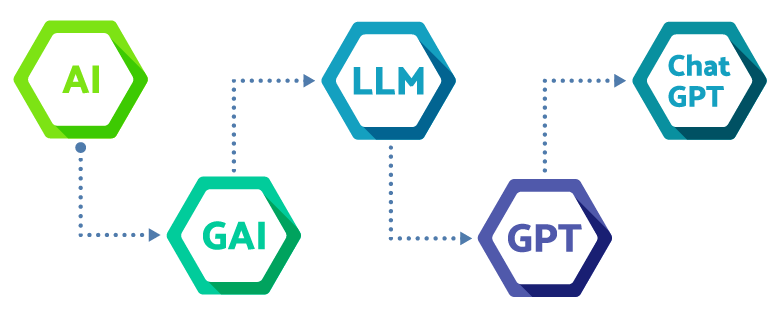Artificial Intelligence (AI) is no longer a buzzword, but a reality in our technology-driven world. From Siri to Alexa, from driverless cars to complex stock market trading algorithms, AI has made its presence felt in virtually every industry. But with the various terms that are often used interchangeably, it’s easy to get confused about the different types of AI and “AI” itself is just the tip of the iceberg. Read more about AI, GAI, ChatGPT, and others, and learn the differences between each of them in our quick guide.

Artificial Intelligence (AI)
AI or Artificial Intelligence has been around in some form since the 1960s and is continuing to evolve. It’s essentially the broader term for any computer program designed to think or perform tasks like a human. AI algorithms can learn from data to translate languages, recognize patterns, make decisions, and solve problems. AI is commonly used in fields like robotics and image recognition, for example. AI can be further categorized into Narrow AI (also known as weak AI) and General AI (also known as strong AI or AGI). Interesting fact: Machine learning (ML) is a form of AI.
Generative AI (GAI)
GAI or Generative AI is a type of ML capable of generating new content such as text, images, video, code, etc. in response to specific prompts. GAI has a greater ability to think independently and generalize what it learns across different tasks, while possessing the ability to understand or learn any intellectual task that a human can. GAI can think, reason, make decisions, and understand complex concepts like humans do with the ultimate goal of creating an AI that is similar to a human in its ability to reason and think.
Large Language Model (LLM)
LLM or Large Language Model refers to AI models that have been trained on vast amounts of data to perform language-related tasks. LLMs consist of neural networks with many parameters that have been pre-trained on large quantities of text using self-supervised or semi-supervised learning (forms of ML). LLMs are a type of GAI since they generate new combinations of text. LLMs can recognize words, phrases, and sentences contextually to understand the meaning of text.
Generative Pre-Trained Transformer (GPT)
GPT or Generative Pre-Trained Transformer is one series of LLMs, created by the company OpenAI that uses advanced AI algorithms to generate high-quality natural language text. GPT uses deep learning to produce human-like text and has been in development since 2018. GPT-3 was a recent version that revolutionized the language AI landscape with its ability to perform an extensive range of language tasks, including writing essays and poetry. GPT-4 is the newest release.
ChatGPT
ChatGPT or Chatbot-Generated Text Predictor a chatbot was initially built on GPT-3.5 and later upgraded to GPT-4. It has been “trained” to interact with humans in a conversational way. This AI system uses a special type of AI algorithm called “transformers” and was designed specifically to generate natural-sounding texts based on a given input. ChatGPT is often used in chatbots, where the goal is to produce natural conversations that are indistinguishable from human conversations, even imitating human emotions and personality traits.
Wrap Up
Understanding what each of these advanced technology does is no simple task, but hopefully our quick guide has cleared up some of the various terms you may come across while reading or learning about AI. AI is undeniably transforming our world, and it’s essential to learn about the different types and their capabilities and how further advancements are driving more efficient solutions for us all. Whether you work in the tech industry or not, AI will continue to shape our future and understanding the different variations of AI will allow you to appreciate the technology’s power and efficiency. Going forward, let’s embrace AI’s advancements and use them to create a better world.
Prakat Solutions specializes in delivering advanced software and IT solutions for businesses around the world, including AI, GAI, GPT, and others. Contact us today to learn more about Prakat’s unique offerings or visit our What’s New section to discover more about AI within the software industry.






